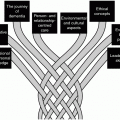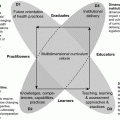- Environmental design
Environmental design is the process of addressing surrounding environmental factors when devising plans, programs, policies, buildings or products.
| PRINCIPLE 1: Unobtrusively reduce risks |
|---|
| People with dementia require an internal and external environment that is safe, secure and easy to move around if they are to make the best of their remaining abilities. However, obvious safety features and barriers will lead to frustration, agitation and anger, and so potential risks need to be reduced unobtrusively. |
| PRINCIPLE 2: Provide a human scale |
|---|
| The scale of a building will have an effect on the behaviour and feelings of a person with dementia. The experience of scale is determined by three factors: the number of people that the person encounters, the overall size of the building and the size of the individual components, such as doors, rooms and corridors. A person should not be intimidated by the size of the surroundings or confronted with a multitude of interactions and choices. Rather the scale should help the person feel in control. |
| PRINCIPLE 3: Allow people to see and be seen, and provide visual access to frequently used locations |
|---|
| An environment that allows people to see their destination will help to minimise confusion. It should also enable staff to see patients from where they spend most of their time. This assists with the monitoring of the patients and reassures patients of their safety. |
| PRINCIPLE 4: Reduce unhelpful stimulation |
|---|
| Because dementia reduces the ability to focus on only those things that are important, a person with dementia can become stressed by prolonged exposure to large amounts of stimulation. The environment should be designed to minimise exposure to stimuli that are not helpful. The full range of senses must be considered. Too much visual stimulation, for example, is as stressful as too much auditory stimulation. |
| PRINCIPLE 5: Optimise helpful stimulation |
|---|
| Ensuring that items that the patient needs to be aware of are strongly highlighted will increase the chance of them being noticed and used. Providing multiple cues using vision, hearing, smell and touch will help to compensate for sensory losses. |
| PRINCIPLE 6: Support movement and engagement, inside and outside |
|---|
| Aimless wandering can be minimised by providing a well-defined pathway, free of obstacles and complex decision points, to guide people past points of interest. It also gives them opportunities to engage in activities or social interaction. The pathway should be both internal and external, providing an opportunity and reason to go outside when the weather permits. |
| PRINCIPLE 7: Create a familiar space |
|---|
| The person with dementia is more able to use and enjoy spaces and objects that were familiar to them in their early life. The environment should afford them the opportunity to maintain their competence through the use of familiar furniture, fittings and colours. The involvement of the person with dementia in personalising the environment with their own familiar objects should be encouraged. |
| PRINCIPLE 8: Provide a variety of spaces to be alone or with others |
|---|
| People with dementia need to be able to choose to be on their own or spend time with others. This requires the provision of a variety of spaces that prompt a range of activities, e.g. reading alone, conversing with one or two others or engaging in larger group activities. |
| PRINCIPLE 9: Provide links to the community |
|---|
| Without constant reminders of who they were and are, a person with dementia will lose their sense of identity. The best people to remind them are their family and friends. The environment should therefore provide comfortable opportunities for visitors to spend time interacting with the patient. |
| PRINCIPLE 10: Support the values and goals of care |
|---|
| An environment that embodies the values and goals of care, e.g. provides opportunities for engagement with the ordinary activities of daily living to support rehabilitation goals, will assist the person with dementia to respond appropriately, and the staff to deliver the desired care. |
The relevance of these principles to the quality of life of people with dementia in residential care has been evaluated in a study involving 275 residents in 35 aged care homes (Fleming et al., 2014). The quality of the environment in these homes was assessed by the use of an audit tool (Fleming, 2011; Fleming, Forbes & Bennett, 2003) based on the 10 principles outlined in Table 10.1 and the quality of life of the residents was assessed by the use of the Dementia Quality of Life (DEMQOL) assessment tool (Smith et al., 2007). Analyses utilising linear regression controlling for a wide range of variables (including gender, age, severity of dementia, medication usage, physical incapacities, number of psychiatric diagnoses and a measure of ability to engage in activities of daily living), identified a significant association between the scores of the global quality of life item of the DEMQOL and the scores of Fleming’s Environmental Audit Tool. The quality of the environment, as measured by the Environmental Audit Tool total score, accounted for 14.6% of the variance in quality of life. Further analysis revealed that the provision for alternatives to wandering, familiarity, provision of spaces for privacy and social interaction, and provision of opportunities for engagement in domestic activities were the significant environmental characteristics that contributed to self-reported quality of life.
The quality of the environment was in fact the second best predictor of quality of life, only beaten by the ability of the person with dementia to be involved in activities of daily living – an ability that cannot be expressed without the availability of an environment to support them.While this is relatively new research, the evidence for the positive influence of the environment on a wide range of individual problems, such as disorientation and agitation, has been around for a long time. So why is it that so many people with dementia live in unsatisfactory aged care homes? One way of unravelling the problem is to look at it from a knowledge translation point of view.
Applying knowledge translation
Knowledge translation (KT) is the process of putting knowledge into practice (Straus, Tetroe & Graham, 2009). There are many views and theories on how this might be achieved; in fact it has been estimated that there are more than 90 terms used to describe this process (Straus, Tetroe & Graham, 2009). One of the most straightforward and useful models describes the process as occurring in four stages. If knowledge is to be translated into practice, the potential knowledge users must first become aware of is the existence of the evidence for example, by reading an article or attending a class. In the second stage, the users must evaluate the new knowledge and come to the conclusion that it is credible, and that they agree with it. In the third stage, the knowledge must be adopted into practice and in the fourth stage – adherence – the new application becomes business as usual, often as the result of the development of regulations to ensure compliance with accepted good practice (Pathman et al., 1996).
- Knowledge translation (KT)
Knowledge translation is the term often used to describe integration of research into practice where the intent is clear from the beginning of the research (Johnson, 2005).
This model of KT was used in an investigation of the obstacles to the application of our knowledge on designing aged care homes for people with dementia (Fleming, Fay & Robinson, 2012). Ten Australian aged care homes, which had recently completed renovations to make them more suitable for people with dementia, were identified, and their managers and architects agreed to participate in the study. The quality of the environment was assessed by the use of an audit tool based on the 10 principles outlined in Table 10.1 (Fleming, 2011; Fleming, Forbes & Bennett, 2003). The managers and architects responsible for the renovations were interviewed to establish their awareness of, and agreement with, the principles. Five of the managers were quite well aware of the principles and agreed with them. All of the architects claimed to be familiar with the principles and agreed with them. Analysis of the difference in the audit tool scores revealed that those facilities that had been renovated by teams comprising an architect and manager, who were aware of and agreed with the principles, scored significantly better than those renovated by teams in which the manager was not aware of the principles. This positive result was quite surprising as it is difficult to get a statistically significant difference in such a small sample.
The result could not be explained in terms of problems with the construction process, cost or corporate policies, as the responses to the structured interviews showed no difference in the impact of these variables on the renovations.
This small study sheds some light on the importance of awareness of new knowledge. The renovations that took place under the control of managers who were not aware of the principles were significantly poorer than those controlled by managers who knew about the principles. This is perhaps not a surprising finding. However, all of the teams had at least one stakeholder – the architect – who did know about the principles. So the team as a whole could be said to have been aware of the knowledge but the influence of the key stakeholder – the manager – appears to have overridden a move to good practice.
On one hand, this suggests that the solution to the problem is to ensure that all managers of aged care homes, who are very often nurses, are educated in how to use the built environment as a tool for improving the quality of life of people with dementia. On the other hand, it can be argued that this knowledge was available and the problem lies in the lack of collaboration between the professions, nurses and architects. This would seem to be a situation which could be improved by a willingness to adopt interprofessional learning (IPL), summarisedby the Australasian Interprofessional Practice and Educational Network (n.d.) as:
a philosophical stance, embracing lifelong learning, adult learning principles and an ongoing, active learning process, between different cultures and health care disciplines. IPL philosophy supports health professionals working collaboratively in a health care setting, through a purposeful interaction with service users and carers, to produce quality patient centred care. It acknowledges both formal and informal methods of learning which progress to develop service delivery.
Stay updated, free articles. Join our Telegram channel

Full access? Get Clinical Tree






